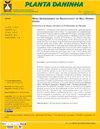Weeds Associated with Banana Crops in Magdalena Department, Colombia
IF 0.8
Q3 Agricultural and Biological Sciences
引用次数: 5
Abstract
ABSTRACT: This study was conducted to determine the richness and composition of weed communities associated with banana plantations in Magdalena department, Colombia. Between September 2016 and May 2017, a total of 164 hectares were assessed over four agroecological zones (Alta, Media, Baja and Norte); in each zone, three representative farms were selected where, through zigzag paths, botanical collections were made in cultivated lots. Information on life cycle, growth habit and origin of each species was included. The floristic composition was represented by 204 species distributed among 143 genera and 54 families. Poaceae, with 31 species, was the family with the highest species richness, followed by Fabaceae (12) and Asteraceae (11). From the total species recorded, 113 are perennial (55%) and 91 are annual (45%); 141 species are herbaceous (68%), 38 are climbers (20%), and 25 are arboreal or shrubby (12%). Native species predominate over introduced species. The species richness does not differ significantly between the sampling zones, but the weed community composition does. The presence of common species reported as important weeds worldwide was recorded in the four zones. However, some species were recorded in only one of the zones, generating a differential composition pattern. Comparison with local inventories showed changes in the composition of the weed complex over time. The presence of various species not previously considered weeds in the banana crops of this region is highlighted.哥伦比亚马格达莱纳省与香蕉作物有关的杂草
摘要:本研究旨在研究哥伦比亚马格达莱纳省香蕉种植园杂草群落的丰富度和组成。2016年9月至2017年5月期间,在四个农业生态区(上、中、下和北部)共评估了164公顷土地;在每个区域,选择了三个具有代表性的农场,通过曲折的路径,在耕地中采集植物。每个物种的生命周期、生长习性和起源信息都被包括在内。植物区系组成有204种,分属54科143属。物种丰富度最高的科是禾本科,共有31种,其次是豆科(12种)和菊科(11种)。其中多年生113种(55%),一年生91种(45%);草本植物141种(68%),攀缘植物38种(20%),乔木或灌木25种(12%)。本地种比引进种占优势。不同取样带间物种丰富度差异不显著,但杂草群落组成差异显著。在这四个区域记录了世界范围内重要杂草的常见种类。然而,一些物种仅在其中一个区域记录,产生了差异的组成格局。与当地库存的比较显示了杂草复合体的组成随时间的变化。强调了该地区香蕉作物中存在的各种以前未被认为是杂草的物种。
本文章由计算机程序翻译,如有差异,请以英文原文为准。
求助全文
约1分钟内获得全文
求助全文
来源期刊

Planta Daninha
Agricultural and Biological Sciences-Plant Science
自引率
0.00%
发文量
0
审稿时长
16 weeks
期刊介绍:
Planta Daninha is a scientific journal published by the Brazilian Society of Weed Science (SBCPD - Sociedade Brasileira da Ciência das Plantas Daninhas). Papers submitted for publication must be sent through an electronic system, on http://www.scielo.br/pd. Works may be written in Portuguese, English, or Spanish, and will be accepted after being reviewed and approved by the Editorial Board. Only papers that have not been published or submitted for publication in other media will be accepted. Articles in Portuguese will be translated to English after being properly corrected and authorized by the authors. Planta Daninha has with goal to publish genuine technical-scientific papers and literature reviews from a critical perspective on Biology, weed management, and related topics.
 求助内容:
求助内容: 应助结果提醒方式:
应助结果提醒方式:


